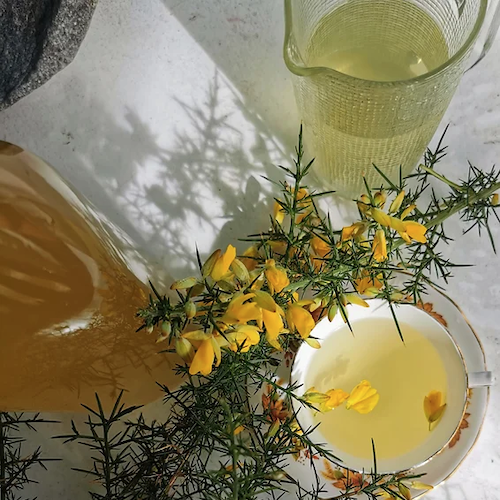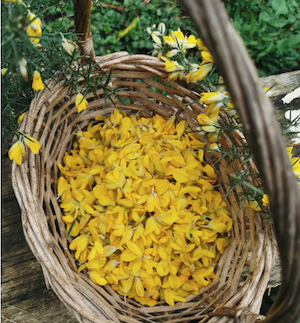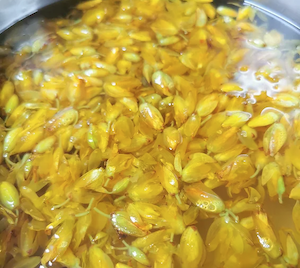Who knew Gorse flowers were so beneficial for your health! This week we are sharing another inspired wild weed recipe from Anna Valentine of The Veggie Tree.
Gorse flowers are a classic of the pea family with its small, bright yellow, butterfly shape, which seek the suns warmth to bring out the sweet coconut vanilla flavour, this dense prickly evergreen shrub with spiny branches is considered as one of the peskiest weeds in New Zealand, but don’t hate on it just yet as it does have many qualities as well.
The flowers when picked on a sunny day, otherwise they can be a little bitter, can be made into a cordial, tea or wine.
From Anna …
The flavour is fabulous when infused into cream which can then be made into custards, ice cream and panacotta, I’ve also included adding a creamy element to my jelly cups recipe here. The flowers can also be used as a garnish, added to salad or to top sweet baking.
Gorse tea is helpful for regulating blood pressure and diabetes, you can take it as a general tonic to strengthen your constitution, it relieves throat irritation and supports the lungs, so is perfect for coughs, colds, sore throats, strep, scarlet fever and asthma. To make a tea take 2 teaspoons of fresh gorse flowers infused in a cup of hot water for 5-10 minutes, strain flowers out if preferred once steeped. It improves intestinal flora so will improve gut health, it also detoxifies and strengthens the liver and kidneys. It supports the heart and is great for the skin also. Gorse flowers contain 17% protein and it is said that lactating animals ‘give good milk’ when eating gorse in their diet. The elastic seed vessels burst in hot weather with a crackling noise and scatter everywhere. In traditional herbal medicine, the seeds were soaked and used as a flea repellent.
Ulex europaeus supports soil health by fixing nitrogen and land stability on hillsides, creating a nursery for birds, insects and a micro climate for small plants and trees. As the native trees grow they will shade out gorse which it doesn’t like, and will then die off. It can be used as kindling or a very effective fence, and the ashes from the burnt wood are rich in potassium, which makes a great fertiliser, or can be mixed with vegetable oil and made into soap as it has a high alkali content.
As a flower remedy, gorse is used primarily for feelings of hopelessness and despair, creating uplifting positive vibes within. The ancient Celtic people associated gorse with fire, light and sun, which is fascinating as gorse flowers in the late wintertime and early spring here in New Zealand, which is Leo season if you are familiar with astrology, Leo also has these associations, we still have our winter fires burning, as it gets lighter and the sun warmer. They used it to offer protection against misfortune, with its bright yellow flowers always seeking warmth, forever chasing the sunlight, which is essential for the flavour of the flowers.
Anna’s Gorse Flower Cordial
Gather gorse flowers on a sunny day for the best flavour. Take care of the spikes and use gloves if preferred, I find mindfully gently plucking little clusters of flowers the best way to not get spiked. This beverage can be enjoyed with hot, cold or fizzy water, 3-4 tablespoons of cordial per 500ml water.
You could also use this cordial in a cocktail or freeze into a granita, ice blocks or see this recipe of Anna’s for how to make into jelly’s.
Ingredients
2 cups gorse flowers
1L water
1 1/2 cups sugar
1 tablespoon zest, lemon, lime and/or orange
Juice of 1 lemon, lime or orange
Method
Add the sugar, water and zest to a pot, bring to the boil, then simmer for 5 minutes. Remove the pot from the heat and add the lemon juice and gorse flowers to the syrup. Stir in well and leave until cooled or overnight. Strain the liquid through muslin or similar. Pour into a sterilised glass bottle and cap, keep in the fridge. If you want to keep the cordial for longer than one month, heat the cordial until simmering and pour into a warm sterilised bottle and cap, it will create a seal once it cools.
Check out Anna’s fantastic recipe books, delicious condiments and upcoming workshops here.








About The Author: Triona Backup
More posts by Triona Backup